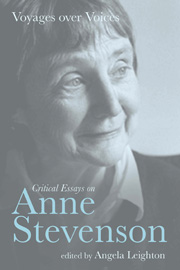Book contents
- Frontmatter
- Contents
- Notes on Contributors
- Acknowledgements
- ‘Making Poetry’
- 1 ‘Voyages over voices’: Introduction
- 2 The Melting Metaphor
- 3 ‘Between us’: Letters and Poems of Stevenson and Bishop
- 4 Mothers, Mirrors, Doubles: Anne Stevenson's Elegies for Sylvia Plath
- 5 Staging Second Thoughts: The Poetry of Anne Stevenson
- 6 ‘Making Poetry’: The Exemplary Anne Stevenson
- 7 ‘A curved adventure’: Romanticism and the Poetry of Anne Stevenson
- 8 The Nature of Anne Stevenson
- 9 Anne Stevenson and the Poetry of Place
- 10 Compacting Time: Anne Stevenson's Poems of Memory
- 11 ‘Not exactly a persona’: Pronouns in Anne Stevenson's Poetry
- 12 ‘To serve a girl on terrible terms’: Anne Stevenson's Writing Selves
- 13 Talking and Singing: Anne Stevenson's Variations on a Rhythmical Theme
- 14 ‘Time will erase’: Anne Stevenson and Elegy
- 15 Observing the Overhearing: The Anne Stevenson Papers in Cambridge University Library
- 16 Bibliography of Anne Stevenson's Published Works
- General Index
- Index of Stevenson's Works
7 - ‘A curved adventure’: Romanticism and the Poetry of Anne Stevenson
- Frontmatter
- Contents
- Notes on Contributors
- Acknowledgements
- ‘Making Poetry’
- 1 ‘Voyages over voices’: Introduction
- 2 The Melting Metaphor
- 3 ‘Between us’: Letters and Poems of Stevenson and Bishop
- 4 Mothers, Mirrors, Doubles: Anne Stevenson's Elegies for Sylvia Plath
- 5 Staging Second Thoughts: The Poetry of Anne Stevenson
- 6 ‘Making Poetry’: The Exemplary Anne Stevenson
- 7 ‘A curved adventure’: Romanticism and the Poetry of Anne Stevenson
- 8 The Nature of Anne Stevenson
- 9 Anne Stevenson and the Poetry of Place
- 10 Compacting Time: Anne Stevenson's Poems of Memory
- 11 ‘Not exactly a persona’: Pronouns in Anne Stevenson's Poetry
- 12 ‘To serve a girl on terrible terms’: Anne Stevenson's Writing Selves
- 13 Talking and Singing: Anne Stevenson's Variations on a Rhythmical Theme
- 14 ‘Time will erase’: Anne Stevenson and Elegy
- 15 Observing the Overhearing: The Anne Stevenson Papers in Cambridge University Library
- 16 Bibliography of Anne Stevenson's Published Works
- General Index
- Index of Stevenson's Works
Summary
In her nimbly rhymed and deftly redefining ‘This’, Anne Stevenson finds synonyms for an erotic ‘X’ that might also be ways of describing the poem she is writing:
This is negation of adulthood's rule
that talks by rote.
This is travelling out to where
a curved adventure
splashes on planes of sunlight to become
one perfectly remembered room…
The ‘curved adventure’ is a phrase that surfs the off-rhyming wave of sound coiled up in ‘travelling out to where’, and it seems peculiarly right for this ‘travelling’, daring poet that ‘where’ should find a sonic and semantic companion in the onward-moving word ‘adventure’. Whatever the overt meaning of the ‘curved adventure’, and sexual intercourse has to be a principal contender, it acts as an invitation to us to attend to the curving shape of the lines themselves; the poem's ‘adventure’ bequeaths ‘one perfectly remembered room’ that is also ‘the always has been’, ‘home’, and a place that houses and unites ‘I and you’.
The lyric's own ‘curved adventure’ acts out the plot of many Stevenson poems. Her poetry searches for ‘home’, for unity, whether of time or persons, with the desire and passion that are locatable in Romantic poetry, leaving us grateful for the work that results: work that is itself, many times over, ‘one perfectly remembered room’. Yet there is no seamless, painless transition from English Romantic poetry involved in the writing of this transatlantic poet.
- Type
- Chapter
- Information
- Voyages over VoicesCritical Essays on Anne Stevenson, pp. 98 - 115Publisher: Liverpool University PressPrint publication year: 2010

